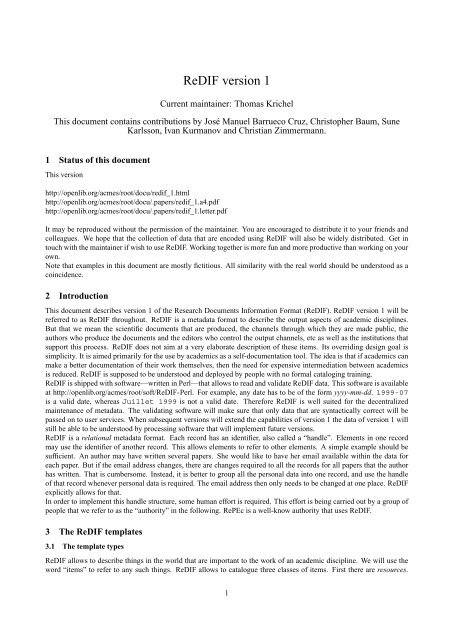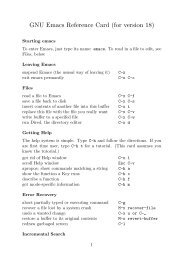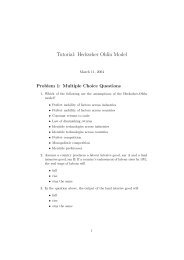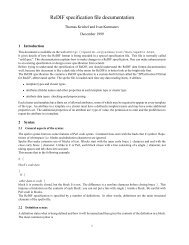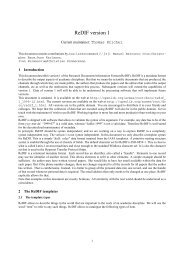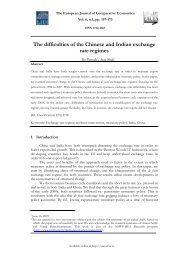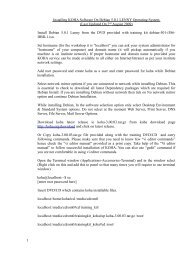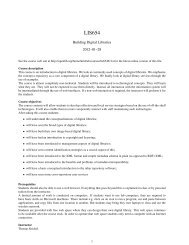ReDIF version 1 - Open Library Society, Inc.
ReDIF version 1 - Open Library Society, Inc.
ReDIF version 1 - Open Library Society, Inc.
You also want an ePaper? Increase the reach of your titles
YUMPU automatically turns print PDFs into web optimized ePapers that Google loves.
<strong>ReDIF</strong> <strong>version</strong> 1Current maintainer: Thomas KrichelThis document contains contributions by José Manuel Barrueco Cruz, Christopher Baum, SuneKarlsson, Ivan Kurmanov and Christian Zimmermann.1 Status of this documentThis <strong>version</strong>http://openlib.org/acmes/root/docu/redif_1.htmlhttp://openlib.org/acmes/root/docu/.papers/redif_1.a4.pdfhttp://openlib.org/acmes/root/docu/.papers/redif_1.letter.pdfIt may be reproduced without the permission of the maintainer. You are encouraged to distribute it to your friends andcolleagues. We hope that the collection of data that are encoded using <strong>ReDIF</strong> will also be widely distributed. Get intouch with the maintainer if wish to use <strong>ReDIF</strong>. Working together is more fun and more productive than working on yourown.Note that examples in this document are mostly fictitious. All similarity with the real world should be understood as acoincidence.2 IntroductionThis document describes <strong>version</strong> 1 of the Research Documents Information Format (<strong>ReDIF</strong>). <strong>ReDIF</strong> <strong>version</strong> 1 will bereferred to as <strong>ReDIF</strong> throughout. <strong>ReDIF</strong> is a metadata format to describe the output aspects of academic disciplines.But that we mean the scientific documents that are produced, the channels through which they are made public, theauthors who produce the documents and the editors who control the output channels, etc as well as the institutions thatsupport this process. <strong>ReDIF</strong> does not aim at a very elaborate description of these items. Its overriding design goal issimplicity. It is aimed primarily for the use by academics as a self-documentation tool. The idea is that if academics canmake a better documentation of their work themselves, then the need for expensive intermediation between academicsis reduced. <strong>ReDIF</strong> is supposed to be understood and deployed by people with no formal cataloging training.<strong>ReDIF</strong> is shipped with software—written in Perl—that allows to read and validate <strong>ReDIF</strong> data. This software is availableat http://openlib.org/acmes/root/soft/<strong>ReDIF</strong>-Perl. For example, any date has to be of the form yyyy-mm-dd. 1999-07is a valid date, whereas Juillet 1999 is not a valid date. Therefore <strong>ReDIF</strong> is well suited for the decentralizedmaintenance of metadata. The validating software will make sure that only data that are syntactically correct will bepassed on to user services. When subsequent <strong>version</strong>s will extend the capabilities of <strong>version</strong> 1 the data of <strong>version</strong> 1 willstill be able to be understood by processing software that will implement future <strong>version</strong>s.<strong>ReDIF</strong> is a relational metadata format. Each record has an identifier, also called a “handle”. Elements in one recordmay use the identifier of another record. This allows elements to refer to other elements. A simple example should besufficient. An author may have written several papers. She would like to have her email available within the data foreach paper. But if the email address changes, there are changes required to all the records for all papers that the authorhas written. That is cumbersome. Instead, it is better to group all the personal data into one record, and use the handleof that record whenever personal data is required. The email address then only needs to be changed at one place. <strong>ReDIF</strong>explicitly allows for that.In order to implement this handle structure, some human effort is required. This effort is being carried out by a group ofpeople that we refer to as the “authority” in the following. RePEc is a well-know authority that uses <strong>ReDIF</strong>.3 The <strong>ReDIF</strong> templates3.1 The template types<strong>ReDIF</strong> allows to describe things in the world that are important to the work of an academic discipline. We will use theword “items” to refer to any such things. <strong>ReDIF</strong> allows to catalogue three classes of items. First there are resources.1
A resource is either a digital string of information or anything that can be digitized. A book for example may not bedigital but can be digitized, and therefore it is a resource. A second group of items are tangibles. These are objectsof descriptions that can not be digitized. A person for example falls into that category. Finally, there are collections.These are manifolds that have a mixed nature that makes it difficult to decide whether they are tangibles or resources. Inthe following table, we list the items, the <strong>version</strong> of the <strong>ReDIF</strong> template that describes it, a description of the item, andfinally the class of item.item name Version concern class<strong>ReDIF</strong>-paper 1.0 a research report that is not formally published resource<strong>ReDIF</strong>-article 1.0 a research report in a scientific journal resource<strong>ReDIF</strong>-chapter 1.0 a research report in a book resource<strong>ReDIF</strong>-book 1.0 a book resource<strong>ReDIF</strong>-software 1.0 an executable software or a software script resource<strong>ReDIF</strong>-archive 1.0 describes a archive where templates are stored collection<strong>ReDIF</strong>-series 1.0 describes a series of templates of the items above, e.g. a scientificcollectionjournal<strong>ReDIF</strong>-institution 1.0 an institution, e.g. a research center tangible<strong>ReDIF</strong>-person 1.0 a person, who could be an author of a paper, editor of a journaletc.tangible3.2 The <strong>ReDIF</strong> syntax<strong>ReDIF</strong> splits all the information concerning an item into a set of data elements. By data element we mean an elementarypiece of information that we do not wish to split further. The whole set of data elements that describe an item forms thebibliographic record or “template” of this item. “Attribute” and “field” are two synonyms for a data element.The <strong>ReDIF</strong> templates aim to compromise between human and machine readability. The general syntax for a field isdata_element_name:data element valuewhere data_element_name would for example be Author-Workplace-Phone and the data element value would be +44(0)1483876958. Of course we could split the telephone number into an international dialing code, a city code and a localcode, but that would go beyond what our data is actually needed for. The field name must be separated from the fieldvalue by a colon and optional whitespace. By a whitespace we mean a space character or a tabulation character or anycombination of those.Field names may contain only alphanumeric characters, the hyphen - and the hash sign #. No embedded spaces areallowed. Field names are case insensitive. Any field that starts with X- is considered to be local. The parsing softwarewill read it but make no checks on the values.Any field value may be continued (or even started) on the next line by adding a whitespace at the beginning of thecontinuing line. Multi-line field values are delimited by the first line which does not have a whitespace character in thefirst position, or is blank. Thus all lines containing field names should have no whitespace characters in the beginning ofthe line.The default character set for field values is ISO-8859-1. This is close to what is called Latin-1 on most machines andclose enough to the standard Microsoft Windows character set. It is also the character set that is used in the HypertextTransfer Protocol (http).Many fields may be repeated within one record, but repetitions are discouraged and for some fields they are prohibited.But for example, here is a person who works in two placesAuthor-Name: Sturm, J.F.Author-Workplace-Name: Erasmus University Rotterdam,Econometric InstituteAuthor-Workplace-Name: Center for Economic Policy Research3.3 Order of fields in the templateThe general principle is that all fields may appear in any order within the template. However there are two importantexceptions to this rule.First, every <strong>ReDIF</strong> templates must start with the Template-type: field. The value of this field indicates what type ofresource will be described by this template. Therefore, the set of expected fields in the template itself depends on thatvalue. The values for the template type are given in Subsection 3.1. The <strong>version</strong> number must be quoted after thetemplate type. The <strong>version</strong> number will make it easier to implement changes to <strong>ReDIF</strong>. At the moment all template types2
the Author-Email: field is not recognized, because at that point the Author-(PERSON*) cluster has not yet started. Thiswill result in an error message or in your template being ignored. But the Author-Name: field that follows will startthe cluster, because “Name” is the key field of the (PERSON*) cluster. Hence the Author-Phone: field will be correctlyprocessed.This is all you need to know about clusters in general. We now address the specifics of the different cluster types.4.1 The ORGANIZATION* clusterThe ORGANIZATION* cluster is defined by the following fields:Name DescriptionName Name of organization, the keyHomepage URL of organization’s home pageName-English English translation of the name of organizationPostal Postal Address of organizationLocation Name of place where organization is based, e.g. “Harare”Email Electronic mail address(es) of organizationPhone Telephone number(s) of organizationFaxFax number(s) of organizationInstitution Handle of an institution template that describes the organizationName is the key field of the organization cluster. It should always be put first. Otherwise the most useful item is thehomepage. Much of the remaining information can be derived from the homepage. It should be supplied if the homepageinformation is missing or the data at the homepage is not specific enough.Here is an example of the organization cluster use to describe the provider of a working paper series.Provider-Name: Board of Governors of the Federal Reserve SystemProvider-Homepage: http://www.bog.frb.fed.us/Provider-Email: fedspapers@frb.govIf a <strong>ReDIF</strong> institution template is available, then a better way to write to describe this institution isProvider-Name: Board of Governors of the Federal Reserve SystemProvider-Institution: RePEc:edi:frbgvusIn that case, the data of the institution template is used to describe the institution. It is then no longer necessary to giveany further details about the institution within the template. The advantage of this representation is that when thereis a change in the data for the institution, it is no longer necessary to update the data for the institution within each(ORGANIZATION*) cluster within each (PERSON*) cluster of every author who has written a paper when affiliatedwith that institution.4.2 The Person clusterThe PERSON cluster is used to describe a person. It has the following fieldsNameDescriptionNameName of person, the keyHomepageURL of person’s home pageWorkplace-(ORGANIZATION*) Organization in which person worksEmailElectronic mail address(es) of personFaxFax number(s) of personPostalPostal address of personPhoneTelephone contact informationPersonHandle of a person template that describes the personName is the key field of the person cluster. It should always be put first.If a <strong>ReDIF</strong> person template for a person is available, then there is easy way to describe a person. This is done throughthe person template. For exampleAuthor-Name: Thomas KrichelAuthor-Person: RePEc:per:1965-06-05:thomas_krichelNow all the information about the person, including the workplace data, is read from the person handle. No furtherinformation about the person needs to be entered.4
4.3 The FILE clusterThe (FILE*) cluster is used to describe a file that contains the resource that is being described, or a part of it.Name DescriptionURL Uniform Resource Locator of file, the keyFormat The format, e.g. “application/pdf” for PDF filesFunction explains the function of file within the resourceSize The file size, by default in kilobytesRestriction A restriction placed on accessing the fileThese fields of the (FILE*) cluster are not as the fields of the previous clusters. We describe each of them in more detail.URL: This is the Uniform Resource Locator (URL) of the file on the Internet. The URL identifies an access protocol anda code that this protocol can use to retrieve the resource. Please refer to RFC1783 at ftp://ftp.isi.edu/in-notes/rfc1738.txtwhen composing a URL. Any whitespace in the URL will be ignored. Following RFC1783 any whitespace that follows adash character “-” is considered to be a mistake, because it is likely to have been introduced by word processing software.The URL can be written over several lines, but do not break it after a dash.File-URL:http://www.hhs.se/research/wpecofi/papers/wp0121.pdf.zipFile-URL: ftp://crefe.dse.uqam.ca/pub/cahiers/cah44.psThis is the key field of the file cluster. It should always be put first.Format: This is a an optional field to give a precise indication about the type of format that is found in the field. The fieldFormat: is not repeatable and is case-insensitive. The contents of this field (all valid values) is restricted by a controlledvocabulary, the MIME Multipurpose Internet Mail Extensions types. These types are specified in the RFC1521 atftp://ftp.isi.edu/in-notes/rfc1521.txt. The complete and up-to-date list of these types is maintained by theIANA. We do not support any values for file format that are not listed there. If you want to convey information about atype that is not registered here, please contact the IANA. The most important MIME types that are used by the <strong>ReDIF</strong>collections are application/pdf and application/postscript, as well text/html. If you simply wantto give a message to the user about the file, it is best to use the Function: field.Function: This is the function of the file. It should be used when a file represents only some part of the whole resource.The field value may indicate what particular part of the document is represented by the file. Here are three examplesFile-Function: Appendix 1File-Function: Main textFile-Function: Fortran program used for the simulationsreported in the paperIf the file is a complete rendering of the resource, the File-Function field should not be used at all. When we havedifferent files with no file function, user services should assume that all are alternative renderings of the complete text.Size: The file size, by default in kilobytes. This is an optional and obsolete field. It is not repeatable. ExamplesFile-Size: 48...File-Size: 1788984 bytesRestriction: A restriction on the retrieval of a file. If the file can be retrieved by anybody with Internet access withoutany preliminary payment or registration, you should not use that field at all. As soon as there is a restriction on thefile many services will be assuming that there is no public access to the file. Some user services may wish to displayonly non-restricted files and your file will not appear there. If all files of a document are restricted, please use the fieldRestriction: in the template of the resource, rather than repeating it for each file of the resource.Two examples for a complete file clusterFile-URL: http://rich.com/papers/d_duck.txtFile-Format: text/plainFile-Function: AbstractFile-URL: http://rich.com/papers/d_duck.pdfFile-Format: application/pdfFile-Function: Main textFile-Size: 13982 bytes5
5 The Collection templatesThe collection templates describe archives and series. We list the fields for these templates by order of importance, themost important is put first.5.1 The Archive templateTemplate-type: <strong>ReDIF</strong>-Archive1.0Each archive template must start with this statement.Handle: This is a mandatory field for the archive handle. The handle of the archive is the name of the authority (forexample RePEc), a : and then the archive_identifier. The archive identifier is proposed by the archive administrator andawarded by the authority. It should not have semantic contents.URL: This is a mandatory field for the archive directory. The URL should either point to a http of ftp site. should endwith the archive code.Maintainer-Email: This is mandatory field for the email of somebody in charge of the archive. It is very important tokeep it this field up-to-date. In particular, it is preferable not to use a personal email address of an employee that maymove on later. It is best to give a general address of the sponsor of the archive. Make sure that the mail is read there andtransmitted to the person who really maintains the archive.Name: This is a mandatory field for the name of the archive. This is a name that will be shown to users when they accesscontents of the archive.Maintainer-Name: This is an optional field for the name of a person that is in charge of the archive.Maintainer-Phone: This is an optional field for the phone number of a person in charge of the archive.Maintainer-Fax: This is an optional field for the fax number of a person in charge of the archive.Classification-scheme: This is an optional field for subject information for the archive. Consult the same field in thePaper template and Appendix A for description.Homepage: This is optional field for the URL of the archive’s homepage. This should point to a location that an enduser may be interested in.Description: This is an optional field for a description of the archive’s contents.Notification: This is an optional field that may be used to specify how new papers in the archive are announced.Restriction: This is an optional field to specify access restriction. It should be handle with care. A restriction mentionedhere applies to all files referred to in all resources of all series in the archive. If the series can be retrieved by anybodywith internet access, you should not use that field at all. If not all of the series that make up the archive are restricted,mention the restriction only in the series templates of the restricted series.Here we have two examples for the archive templatesTemplate-type: <strong>ReDIF</strong>-Archive 1.0Handle: RePEc:bobName: Economics Working Paper Archive at WUSTLMaintainer-Email: bparks@wuecona.wustl.eduURL: ftp://econwpa.wustl.edu/bobTemplate-type: <strong>ReDIF</strong>-Archive 1.0Handle: RePEc:wopName: WoPEc ProjectMaintainer-Email: WoPEc@netec.mcc.ac.ukDescription: This archive collects information about holding ofpapers on those sites that have not (yet) joined RePEc.URL: ftp://netec.mcc.ac.uk/pub/NetEc/RePEc/wopURL: http://netec.mcc.ac.uk/RePEc/wop/5.2 The Series templateTemplate-type: <strong>ReDIF</strong>-Series1.0Each series template must start with this statement.Name: This is a mandatory field for the name of the series.Handle: This is a mandatory field for the handle for the description of the series as made by the archive. The handle ofthe series is the name of the authority, a :, the handle of the archive, a :, and then the series_identifier. This field mustnot contain whitespace. It should not have semantic contents. The series code is awarded by the archive or the authority.Maintainer-Email: This is a mandatory field for the email address of a person who is in charge of the series’ files but6
not necessarily of its contents. The maintainer should be ready receive error reports. As with the archive maintainer’semail, a personal address should be avoided.Type: Each series may only contain one type of templates. This rule is called “Baum’s principle”. The Type: fieldis used to indicate the type. The default type is “<strong>ReDIF</strong>-Paper”. If the type of the elements of the series is “<strong>ReDIF</strong>-Paper”, then this field does not need to be specified. Other legal series types are “<strong>ReDIF</strong>-Software”, “<strong>ReDIF</strong>-Article”,and “<strong>ReDIF</strong>-Book”.Order-Email: This is an optional field for the email address where to send ordering requests to.Order-Homepage: This is an optional field for the URL of a screen where orders can be placed.Order-Postal: Snail mail address where to order the paper.Price: Price for all papers in the series when ordered. Can be overwritten by a separate Price: field in the paperProvider-(ORGANIZATION*): This is the organization that supports the series.Publisher-(ORGANIZATION*): This is a synonym for “provider”. It is valid for historical reasons.Restriction: A restriction on the retrieval of all papers in the series. It has the same meaning as in File cluster. It impliesthat all the files of all the documents in that particular series have this restriction.Maintainer-Phone: This is an optional field for the phone number of the person in charge of the seriesMaintainer-Fax: This is as optional field for the fax number of some person in charge of the seriesMaintainer-Name: This is an optional field for the name of a person that is in charge of the files contained in the series.Description: This can be a short description of the series’ content.Classification-scheme: This is an optional field for a subject for the series according to scheme scheme. Consult thesame field in description of the paper template and Appendix A for description.Keywords[-scheme]: This is an optional field for keywords for the series according to scheme scheme. Consult the samefield in the Paper template and Appendix A for description.Editor-(PERSON*): This is the person responsible for the contents of the series.Notification: This is an optional field to say how how new papers in the series are announced.ISSN: This is the International Standard Serial Number for the series, if available.Here are two examples for series templates.Template-type: <strong>ReDIF</strong>-Series 1.0Name: Computational EconomicsDescription: This is a series for economists who are computer nerds. Youcan not get more of an anorak than that.Maintainer-Name: Bob ParksMaintainer-Email: bparks@wuecona.wustl.eduHandle: RePEc:bob:wuwpcoTemplate-type: <strong>ReDIF</strong>-Series 1.0Name: Departmental Working PapersProvider-Name: East Carolina University, Department of EconomicsProvider-Homepage: http://ecuvax.cis.ecu.edu/~ecrothma/wp.htmMaintainer-Email: ecrothma@ecuvax.cis.ecu.eduHandle: RePEc:wop:eakjkl5.3 The authority templateThis is a draft template.Template-type: <strong>ReDIF</strong>-Mirror1.0Each authority template must start with this declaration.Url: The url where the authority is based. RequiredHandle: The handle of the authority. RequiredExample:Template-type: <strong>ReDIF</strong>-Authority 1.0Url: http://netec.mcc.ac.uk/pub/RePEcHandle: RePEc5.4 The Mirror templateThe mirror template describes what kind of mirror you are running on your machine. This template is obsolete andtherefore no longer included here.7
various manifestation of the paper is a good candidate for an Order-URL:. Note that the URL should be specific tothe paper. If all the papers in the series have the same ordering URLs then that information should be put in the seriestemplate.Classification-scheme: This is the classification number associated with the document. The scheme is a code for aclassification scheme. If there are several classification numbers of the same classification scheme, they will be separatedby a semicolon. This field is not repeatable, unless there are multiple schemes used. Allowed (registered) classificationschemes and codes are listed in the Appendix. If you have documents, classified with some other scheme, just email usyour suggestion, and we will register your scheme. Use:Classification-JEL: C12; C30Abstract: This is the abstract of the document. Although we do not require to have an abstract, but we stronglyrecommend to provide a detailed abstract, because it increases the chance of users finding your document within afull-text database. If you have a long abstract that has several paragraphs, you can leave a blank line. Use:Abstract: This is the first paragraph of the abstract.This is the second paragraph of the abstract.However, please recall that every line that follows the first line has to be indented with at least one blank.Keywords[-scheme]: These are keywords associated with the text. If there are several keywords they will be separatedby a semicolon. Scheme is the keywords scheme’s code but it can also be empty, to say that the keywords do not followa scheme. Keywords: should be used in that case. If you have some keywords scheme, we will register it for you. Use:Keywords: Competition; Consumer economics; Ethics; Philosophy of economicsKeywords: Accounting theory; Accounting principles; Financial accountingContact-Email: This field gives a contact email address for the paper. This does not need to be one of the authors’ emailaddress. In some cases where the author does not wish her email to be in the paper information or when no author emailis available, this field should be used. Use:Contact-Email: Economics_Secretariat@hicks.gross-uni.yyRestriction: A restriction on the retrieval of a paper. This is similar to the field of the same name in the File cluster. Ifthe paper can be retrieved by anybody with internet access, you should not use that field at all. Please do not use thefield to make recommendations of the type “please use outside working hours”, since as soon as there is a restriction ona paper many services will be assuming that there is no public access to it. If not all of the files that make up the paperare restricted, mention the restriction only in the (FILE*) cluster of the restricted.The following elements are not important. They have been introduced to integrate legacy data into <strong>ReDIF</strong>-based system.Note: Any other information that is relevant for the document. This can be its relation to other documents, a word ortwo about the history of the document etc. Use:Note: This was an invited paper to a special issue of theNoddyland Journal of BlasphemyLength: The length of a printed <strong>version</strong> of the document, usually in pages. This field is not repeatable. Use:Length: 29 pagesSeries: This is the series of the document. You can simply name the series here. This field is not repeatable.Number: The number of the paper within the series. This field is not repeatable.Availability: This field can be used to state if a paper is out of print. If the paper is on the net it should not be used. Itcan also be used to say how the get hold of the copy of the paper. This field is not repeatable. Use:Availability: out of printRevision-Date: A date at which the document was changed. The format for the value of that field is the same as inCreation-Date:. This field may be repeated.Revision-Date: 1995-06-30Price: That refers to the price of a printed copy of the document, when ordered through the ordering channels specifiedin the series template. Use:9
Price: $3.00 Surface, $4.00 Air (U.S. $)Price: 15 guilders by mail, free by ftpFor the price of an electronic copy, use the Restriction: field.Publication-Status: This can be used to say if a modified <strong>version</strong> of the document exists, has been forthcoming, etc. ina commercial journal, book or other type of formal publication. It should always start with the word “published” or theword “forthcoming” (case insensitive). Use:Publication-Status: Forthcoming inComputational Statistics and DataPublication-Status: Published in Journal of ArtificialIntelligence Research, Vol.3Publication-Status: Published in American Journal ofAgricultural Economics, 1995, vol. 77, no. 1. pp. 120-134.Publication-Status: Published by University of Arizona PressNotification: to specify how new <strong>version</strong>s of the paper are announced.Here are two examples of <strong>ReDIF</strong> templates of type “<strong>ReDIF</strong>-Paper 1.0”. This is a simple document available only inPostScript format.Template-Type: <strong>ReDIF</strong>-Paper 1.0Author-Name: David CurrieAuthor-Name: Paul LevineAuthor-Email: p.levine@surrey.ac.ukAuthor-Name: Joeseph PearlmanAuthor-Name: Michael ChuiTitle: Phases of Imitation and Innovation in a North-SouthEndogenous Growth ModelAbstract: In this paper, we develop a North-South endogenous growthmodel to examine three phases of development in the South: imitationof Northern products, imitation and innovation and finally, innovationonly. In particular, the model has the features of catching up (andpotentially overtaking) which are of particular relevance to thePacific Rim economies. We show that the possible equilibriadepend on cross-country assimilation effects and the ease ofimitation. We then apply the model to analyze the impact of R&Dsubsidies. There are some clear global policy implications whichemerge from our analysis. Firstly, because subsidies to Southerninnovation benefit the North as well, it is beneficial to the Northto pay for some of these subsidies. Secondly, because the abilityof the South to assimilate Northern knowledge and innovate dependson Southern skills levels, the consequent spillover benefits ongrowth make the subsidizing of Southern education by the Northparticularly attractive.Length: 26 pagesCreation-Date: 1996-07File-URL: ftp://ftp.surrey.ac.uk/pub/econ/WorkingPapers/surrec9602.psFile-Format: Application/postscriptThis is an example of a document from the banking structure conference 1994 at the Federal Reserve Bank of Chicago.Although there is no published working paper series of that kind, we have created a imaginary series with code “fedhbs”.The document is available as PostScript in two parts, or as a zipped PostScript file. Since there is no MIME type for thezipped files, we have left out the File-Function: field.Template-Type: <strong>ReDIF</strong>-Paper 1.0Author-Name: Joseph P.HugesAuthor-Name: William LangAuthor-Name: Loretta J. MesterAuthor-Name: Choon-Geol Moon10
Title: Recovering Techonologies That Account for GeneralizedManagerial Preferences: An Application to Non-Risk-Neutral BanksFile-URL: ftp://test.frbchi.org/pub/bsc/doc13a.psFile-Format: Application/PostScriptFile-Function: Main TextFile-URL: ftp://test.frbchi.org/pub/bsc/doc13b.psFile-Format: Application/PostScriptFile-Function: ChartFile-URL: ftp://test.frbchi.org/pub/bsc/doc13ps.zipFile-Function: Archive of Main text and chartHandle: RePEc:wop:fedhbs:_013Note that only Author-Name, Title and the Handle are mandatory in a template. It is however highly recommended thatyou should also give a Creation-Date, Abstract, Classification and/or Keywords.6.2 <strong>ReDIF</strong> templates for other documentsIn this Subsection, we look at templates that describe other forms of scientific documents. Most of the fields are thesame as in the <strong>ReDIF</strong>-Paper template and thus need no further explanation.6.2.1 The <strong>ReDIF</strong>-Article TemplateAn article is something that appeared in a journal or is forthcoming in a journal. This is a draft template for suchpublications.Template-Type: <strong>ReDIF</strong>-Article 1.0The template must start with this fieldHandle: Handle of journal article. This is a required field. It is of the same form as the handle of the paper template.As far as the series identifier is concerned, only series of articles are admissible here. Note that a journal is a nothingelse than a series of articles. It therefore has a series code like a paper series. It can be refereed to as a “journal code”in casual language, but the reader should keep in mind that as far as the structure of <strong>ReDIF</strong> is concerned the journal isnothing else than a series.The article_code is a concatenation of qualifiers, separated by the underscore character _. Each qualifier is an fieldvaluepair. The field is represented by one letter only. This is best understood by an example.RePEc:xxx:joinec:v19_y1985_i2_Q1_p67-84The qualifiers currently defined are the following. We list a name for the qualifier, the letter of the qualifier, a descriptionof values and a perl regular expression that that can be used to verify the syntax of the qualifier, as well as an optionaladditional check. All regular expressions are case insensitive.Name: volumeLetter: vValue: any sequence of digitsRegEx: v[1-9][0-9]*Name: issueLetter: iValue: any sequence of digitsRegEx: i[1-9][0-9]*Name: yearLetter: yValue: any sequence of four digitsRegEx: y([1-9][0-9]{3})Check: warn if $1 is higher then current year or earlier than 1500Name: pagesValue: number of page where article starts - number of page where the article endsRegEx: pS*([1-9][0-9]*)-S*([1-9][0-9]*)11
Check: $1 should be smaller than $2Here the S stands for “supplement”, just in case that the paper has not been published in the main issue.Name: issueValue: which issue within the year. If the issue is a month, then we give the English three letter start of the month: JAN,FEB MAR, APR, MAY, JUN, JUL, AUG, SEP, OCT, NOV, DEC. The numbers of the months are also allowed here, butthat is discouraged. If the issue is a quarter, we use Q1, Q2 etc. If the issue has a start date, put that date like 04-01 for1 April. Note that you need to put the - separator here because the date is otherwise mistaken to be the number of theissue.There is no need to put an end date for this issue. You can repeat the issue qualifier if the physical issue coversseveral logical issues. SPE can be added to say it is a special editions, and S can be postponed for a supplement.RegEx: i:(($months\d*)($season[S]*)(Q[1234])(\d+)(\d\d-\d\d)) where$month=“(jan|feb|mar|apr|may|jun|jul|aug|sep|oct|nov|dec)” and$season=“(spr|sum|aut|win|spe)”In fact the information thus encoded in the handle can also be encoded in separate fields. These are listed here. Noneof these fields is repeatable. They are fields that are specific to the article template, i.e. they do not appear in the papertemplate.Journal: Name of the journal.Year: Year of publication of the article.Pages: The pages of the article in the journal in the form start-end, where start is the number of the first page and endis the number of the last page.Price: Price of the article if mailed individually.Volume: The volume number that the article appeared in.Month: The month where the journal issue where the article is appeared in.template-Handle: where template may take the values Paper, Book or Chapter. These handles can be quoted if the paperwas published in several places.Other fields are like the paper template except that the following are not valid: Length:, Series: Availability:, Revision-Date: and Article-Handle:.Example:Template-Type: <strong>ReDIF</strong>-Article 1.0Title: Productivity Spillovers from FDI in the UruguayanManufacturing SectorAuthor-Name: Kokko, AriAuthor-Workplace-Name: Dept. of Economics, Stockholm Schoolof EconomicsAuthor-Workplace-Postal: Stockholm School of Economics,P.O. Box 6501, 113 83 Stockholm, SwedenAuthor-Name: Tansini, RubenAuthor-Name: Zejan, MarioAuthor-Workplace-Name: Dept. of Economics, Stockholm Schoolof EconomicsAuthor-Workplace-Postal: Stockholm School of Economics,P.O. Box 6501, 113 83 Stockholm, SwedenJournal: Journal of Development StudiesPages: 602-611Volume: 32Year: 1996Publication-Status: PublishedHandle: RePEc:jou:devstu:v:32:y:1996:i:Q1:p:602-611What happens if you wish to provide data about the formal publication, i.e., within a journal, of a paper for whichyou have <strong>ReDIF</strong>-Paper information. This is called Sune’s problem. The basic status is that it is not possible for you toprovide information about an article that you have published in a journal. It is for the journal or some agent of the journalto provide that information, because all the information about all the articles has to be kept together in once directory.However, you can give the Article handle, and a <strong>ReDIF</strong> literate individual should be able to find the information.12
6.2.2 The <strong>ReDIF</strong>-Software TemplateThis is a draft template.Template-Type: <strong>ReDIF</strong>-Software 1.0)The template must start with this field.Handle: This a required field. It uses the same syntax as the handle in the <strong>ReDIF</strong>-paper template.Title: Name of the software, required, non-repeatable.Programming-Language: This is a controlled vocabulary identifier for the language used. At the moment the onlyallowed value are “c”, “c++”, “fortran”, “gauss”, “mathematica”, “matlab”, “octave”, “ox” and “perl”, “rats”, “shazam”,“stata”. In addition, the term “executable” may be used for directly executable files. All these identifiers are caseinsensitive. This is a required field.Author-(PERSON*): Person cluster for each author, at least one cluster is required, see the paper template for guidance.Abstract: Abstract to describe the principal function of the software.Number: The <strong>version</strong> number of the softwareKeywords: Keywords for the softwareSize: Size of software, usually the number of lines of code.Creation-Date, Revision-Date: as used is in the <strong>ReDIF</strong>-paper template.Note: additional informationRequires: indicates that a certain package <strong>version</strong>, compiler, or operating environment is needed.Example:Template-Type: <strong>ReDIF</strong>-Software 1.0Title: MKSTRSN: Stata modules to format Social Security number variablesAuthor-Name: William GouldAuthor-WorkPlace-Name: Stata CorporationAuthor-WorkPlace-Postal: Stata Corporation, 702 University Drive East,College Station, Texas 77840 USAAuthor-Email: wgould@stata.comProgramming-Language: StataAbstract: mkstrsn and mkdashsn make string variables (without and withdashes,respectively) from a nine-digit variable containing a SocialSecurity number. The commands have the syntax mkstrsn newvar oldvarand mkdashsn newvar oldvar.Series: Statistical Software ComponentsNumber: S328601Creation-Date: 19971212Length: 39 linesClassification-JEL: C87File-URL: ftp://ftp.bc.edu/pub/user/baum/statal/mkstrsn.adoFile-Format: text/plainFile-Function: program codeFile-URL: ftp://ftp.bc.edu/pub/user/baum/statal/mkdashsn.adoFile-Format: text/plainFile-Function: program codeHandle: RePEc:boc:bocode:S3286016.2.3 The <strong>ReDIF</strong>-book TemplateThis is a draft template.Template-Type: <strong>ReDIF</strong>-Book 1.0The template must start with this field.Title: Title of book, required, non-repeatableHandle: This a required field. It uses the same syntax as the handle in the <strong>ReDIF</strong>-paper template.Author-(PERSON*): Person cluster for each author, at least one cluster is required, see the paper template for guidance.Publisher-(ORGANIZATION*): Organization cluster for Publisher, required.Year: Year of publication, required for published books, non-repeatable.Month: Month of publication, non-repeatable.Volume: Volume in multi-volume works, non-repeatableEdition: 2nd, 3rd etc., non-repeatable.13
Series: If the book is part of a series, non-repeatable. For example Series: Springer Lecture Notes in Mathematics,volume 234Editor-(PERSON*): Editor of series.ISBN: ISBN of the book, non-repeatable.Publication-Status: One of “Published” or “Forthcoming”, non-repeatable. “Published” is assumed if field is notpresent.Note: Any additional informationAbstract: Abstract.Classification-scheme: same as for the <strong>ReDIF</strong>-paper templateKeywords[-scheme]: same as for the <strong>ReDIF</strong>-paper template.HasChapter: Chapter handletemplate-Handle: where template may take the values Paper, Article or Chapter. These handles can be quoted if thepaper was published in several places.6.2.4 The <strong>ReDIF</strong>-Chapter TemplateThis template is for chapters with individual authors in a collection of papers. Examples are papers published in conferenceproceedings, reprint volumes and Festschrifts. It is a draft template.Template-Type: <strong>ReDIF</strong>-Chapter 1.0The template must start with this field.Handle: This a required field. It uses the same syntax as the handle in the paper template.Title: Title of chapter, required, non-repeatable.Author-(PERSON*): Person cluster for each author, at least one cluster is required, see the paper template for guidance.Abstract: Abstract.Classification-scheme: non-repeatableKeywords[-scheme]: non-repeatableProvider-(ORGANIZATION*): Organization cluster for Provider. This field required unless the field Sponsor-(ORGANIZATION*)is present.Sponsor-(ORGANIZATION*): Organization cluster for sponsor (organization responsible for conference), requiredunless Provider-(ORGANIZATION*) is present.Book-Title: Title of volume, required, non-repeatable.Editor-(PERSON*): Editor cluster for each editor, at least one cluster is required.Year: Year of publication, required for published papers, non-repeatable.Month: Month of publication, non-repeatable.Pages: Pages in volume, non-repeatable.Chapter: Chapter in volume, non-repeatable.Volume: For multi-volume works, non-repeatable.Edition: 2nd, 3rd etc, non-repeatable.Series: Series that volume is part of, non-repeatable.ISBN: ISBN of volume, non-repeatable.Publication-Status: One of ’Published’ or ’Forthcoming’, non-repeatable. Published is assumed if field is not present.Note: Any additional information.In-Book: Handle of the book that the chapter appeared inPaper-Handle: Handle of working paper template, non- repeatabletemplate-Handle:where template may take the values “Article”, “Paper” or “Chapter” handle if published in several places.Example:Template-Type: <strong>ReDIF</strong>-Chapter 1.0Title: Modelling Economic Relationships with SmoothTransition RegressionsAuthor-Name: Teräsvirta, TimoAuthor-Workplace-Name: Department of Economic StatisticsAuthor-Workplace-Postal: Stockholm School of Economics, Box6501, 113 83 Stockholm, SwedenBook-Title: Handbook of Applied Economic StatisticsEditor-Name: Giles, D.E.A.Editor-Name: Ullah, A.Publisher-Name: Dekker14
Publication-Status: ForthcomingPaper-Handle: RePEc:hhs:hastef:0131Handle: RePEc:hhs:hastef:chp01317 <strong>ReDIF</strong> templates for physical entities7.1 The person templateTemplate-Type: <strong>ReDIF</strong>-Person 1.0The template must start with this field.Handle: The handle of the person template. This is a mandatory field of the formauthority:archive_identifier: yyyy-mm-dd:namestringwhere authority is the code of the authority, archive_identifier is the identifier of the archive, yyyy, mm, dd form a year,month and day of the month of a valid date. This date is called the significant date of the person. It is recommended touse the birthday, but any other date in the lifetime of the person is also admissible. Finally namestring is a name stringthat should resemble the person’s name. Blanks is the name are replaced by the underscore character i.e. _.Name-Full: The full name of the person. This field is mandatory.Name-First: The first name of the person. This is useful when searching for the person’s name in unstructured namedata.Name-Last: The first name of the person. This is useful when searching for the person’s name in unstructured namedata.Email: The email of the person. This is a mandatory field.Homepage: The URL of the homepage.Author-Paper:, Author-Article:, Author-Software:These fields say that the person is the author of a paper, article or software, respectively. The value of these fields mustbe the handle of a valid template.Editor-Series: This field says that the person is an editor of a series. The value of this field must be the handle of a validseries template.Classification-scheme: A subject classification code for the academic area that the person is working in, according tothe scheme scheme.Fax:, Postal:, Phone:, Workplace-(ORGANIZATION*):, Workplace-Institution: are allowed and take the samemeaning as in the person cluster.7.2 The <strong>ReDIF</strong>-Institution templateThis template concerns information about institutions. This information can be used in the other templates by a call tothe appropriate institution handle.Template-Type: <strong>ReDIF</strong>-Institution 1.0Every record must start with this field.The other elements are limted to the types of clusters are allowed in the template. These are refered to asPrimary-(ORGANIZATION*): The main organization.Secondary-(ORGANIZATION*): The second level of the organisation, of example a department.Tertiary-(ORGANIZATION*): The third level of the organisation, for example a group within a department.Examples for the leveling of organizations are: “University of London/London School of Economics Financial MarketsGroup”, or “Federal Reserve Bank of Minneapolis / Research Department”, “Government of Zambia / Ministry of Finance”.These three clusters are organized like the (ORGANIZATION*) cluster. An example for a complete organizationcluster is:Primary-Name: Universite des Grands EspoirsPrimary-Name-English: University of Grand HopesPrimary-Location: Panava-les-FlotsSecondary-Name: Departement d’EconomieSecondary-Name-English: Department of EconomicsSecondary-Email: eco@uge.edu Secondary-Homepage:http://www.eco.uge.edu/Secondary-Phone: (+567)3466356An additional element is:Handle: This has to be a 7 letter handle, the last two characters being the ISO 3166 country codes (us for the UnitedStates, ea foe associations and societies). Examples:15
Handle: RePEc:edi:imfffusHandle: RePEc:edi:mofgvzmHandle: RePEc:fmg:fmlseukAn example for a complete record is:Template-Type: <strong>ReDIF</strong>-Institution 1.0Primary-Name: Government of BahrainPrimary-Location: ManamaSecondary-Name: Bahrain Monetary AgencySecondary-Homepage: http://www.bma.gov.bh/Handle: RePEc:edi:bmagvbhAClassification and keywords schemesA.1 Classification scheme(s)Classification-ACM-1998: The classification scheme used by the Association for Computing Machinery, in its <strong>version</strong>of 1998. Several codes may be given separated by colon, semi-colon or blanks.Classification-ACM-1991: The classification scheme used by the Association for Computing Machinery, in its <strong>version</strong>of 1991. Several codes may be given separated by colon, semi-colon or blanks.Classification-ACM-1964: The classification scheme used by the Association for Computing Machinery, in its <strong>version</strong>of 1964. Several codes may be given separated by colon, semi-colon or blanks.Classification-Ila: The classification scheme proposed in the NASA TechReport TM-1998-208955.Classification-JEL: The classification system of Journal of Economic Literature. It’s usually used to classify economicstexts. For more info see http://www.aeaweb.org/journal/elclasjn.html. Several code may be given separated by colon,semi-colon or blanks.Classification-MSC-1991: The Mathematics classification scheme devised by the American Mathematical <strong>Society</strong>, inits <strong>version</strong> of 1991. Several codes may be given separated by colon, semi-colon or blanks.Classification-MSC-2000: The Mathematics classification scheme devised by the American Mathematical <strong>Society</strong>, inits <strong>version</strong> of 2000. Several codes may be given separated by colon, semi-colon or blanks.A.2 Keywords scheme(s)Attent: This is a thesaurus (list of controlled keywords) which is used for the database “Attent: Research Memoranda”.This database, as well as the thesaurus, is produced and maintained by Tilburg University <strong>Library</strong>. “Attent: ResearchMemoranda” only includes Economics working papers. The thesaurus includes economic and mathematical keywords.For further details contact Corry Stuyts .16


